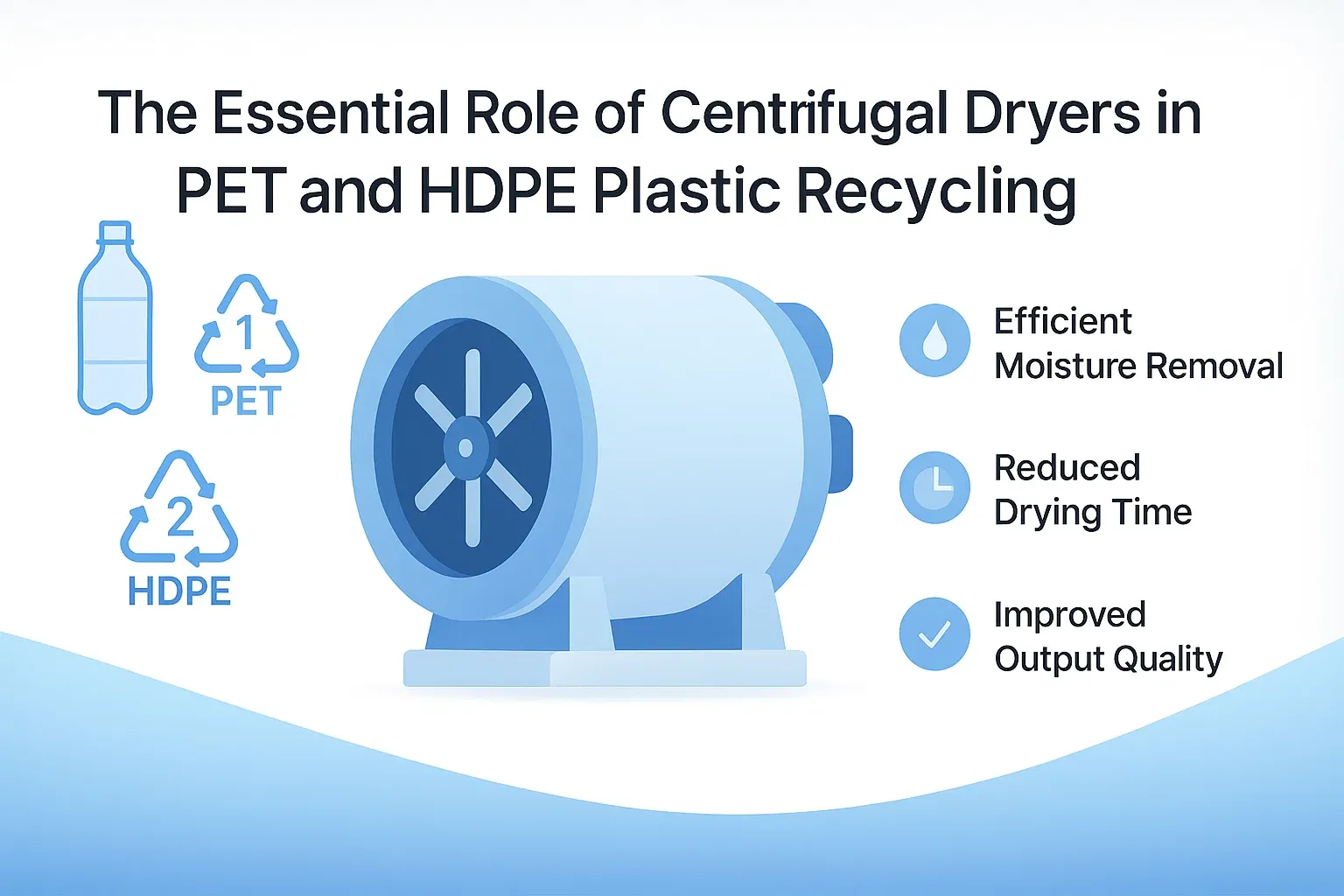In the world of plastic recycling, moisture is a persistent challenge. Efficiently drying plastics like PET (polyethylene terephthalate) and HDPE (high-density polyethylene) is crucial for producing high-quality recycled materials ready for manufacturing. This is where the Centrifugal Dryer steps in as a star player. These innovative machines are pivotal in transforming wet, newly washed plastic flakes and pellets into valuable resources. Join us as we explore how Centrifugal Dryer technology excels in PET and HDPE recycling, detailing its working principles and the significant advantages it brings to the process.
Understanding How a Centrifugal Dryer Works in Plastic Recycling
Imagine a high-speed spinning champion dedicated to drying plastics – that’s essentially a Centrifugal Dryer or a dewatering machine for plastic drying. The process is elegantly simple yet highly effective:
- Feeding the Material: After a thorough washing stage, wet plastic flakes or pellets, commonly PET or HDPE, are introduced into the Centrifugal Dryer.
- High-Speed Rotation: Inside the dryer, a rotor spins at high velocities. This rapid rotation generates powerful centrifugal force.
- Water Expulsion: This force acts on the plastic material, flinging the heavier water particles outwards, away from the plastic and towards the dryer’s screen or casing.
- Separation and Discharge: The separated water is then efficiently drained away, while the now significantly drier plastic material is discharged from the machine.
- Optional Airflow: To enhance the drying effect, some Centrifugal Dryer models may incorporate a stream of ambient or heated air, further reducing residual moisture.
This method is exceptionally well-suited for the flake or pellet forms typical of processed PET and HDPE. The synergy of mechanical force and optional airflow achieves comprehensive moisture removal without compromising the integrity of the plastic.
Why a Centrifugal Dryer is the Go-To Choice for PET and HDPE Recycling
Several key characteristics make the Centrifugal Dryer an ideal solution for recycling PET and HDPE plastics.
1. Unmatched Moisture Removal Efficiency
PET and HDPE plastics, often originating from items like beverage bottles, food packaging, and detergent containers, demand extremely low moisture content for successful reintegration into new products. A Centrifugal Dryer excels here, capable of slashing moisture levels to less than . This remarkable efficiency is vital because any excess moisture can lead to imperfections such as bubbles or structural weaknesses during subsequent manufacturing processes like injection molding or extrusion. Achieving this dryness ensures the recycled PET and HDPE are of premium quality.
2. Preserving Material Quality and Integrity
One of the standout features of a Centrifugal Dryer is its gentle approach. These dryers primarily rely on mechanical force rather than aggressive heat. This is crucial for heat-sensitive plastics like PET and HDPE, as excessive temperatures can degrade their physical and chemical structure. Unlike some thermal drying techniques that risk damaging the plastic, centrifugal drying helps the recycled material maintain its original strength, clarity, and overall durability. This careful handling is particularly beneficial for PET intended for reuse in food-contact applications, where material integrity is paramount.
3. Championing Energy Efficiency
In an era where energy conservation is key, the Centrifugal Dryer stands out. Compared to many alternative drying technologies that depend heavily on thermal energy, centrifugal dryers use significantly less power. Their primary reliance on efficient mechanical separation, rather than prolonged heating cycles, translates directly into lower operational costs and a reduced carbon footprint. This makes them an economically smart and environmentally responsible choice, especially for recycling plants processing large volumes of PET and HDPE.
4. Built for High Throughput Operations
The pace of modern recycling demands machinery that can keep up. Centrifugal Dryer systems are engineered for continuous operation, processing substantial quantities of PET and HDPE flakes or pellets swiftly and effectively. This high throughput capability is essential for recycling facilities aiming to meet robust industry demand, ensuring a steady flow of dried material, minimizing bottlenecks, and maximizing overall plant productivity.
5. Minimizing Contamination Risks
Maintaining the purity of recycled PET and HDPE is non-negotiable. Centrifugal Dryer units contribute significantly to this by operating as enclosed systems. This design inherently protects the plastic materials from airborne dust, dirt, or other external contaminants during the crucial drying phase. The result is a cleaner, higher-quality recycled product, primed and ready for its next life in manufacturing.
Key Benefits of Using a Centrifugal Dryer for PET & HDPE Recycling
The advantages of incorporating a Centrifugal Dryer into PET and HDPE recycling lines extend to product quality, operational costs, and environmental responsibility.
Enhanced Final Product Quality
The ultimate goal of recycling is to produce materials that are just as good, if not better, than their virgin counterparts. A Centrifugal Dryer plays a vital role in achieving this. By meticulously removing moisture, it helps prevent common manufacturing defects such as bubbling, discoloration, or increased brittleness in the final products made from recycled PET and HDPE. This commitment to quality ensures that the recycled plastics offer excellent performance and aesthetic appeal, making them highly competitive.
Significant Cost Savings
Investing in a Centrifugal Dryer is a financially sound decision for any PET and HDPE recycling operation. Their renowned energy efficiency directly translates to lower electricity bills. Furthermore, these robust machines are often designed for durability and require relatively low maintenance, further reducing long-term operational expenditures. Consistent performance coupled with these savings makes the Centrifugal Dryer a smart investment that pays dividends.
Positive Environmental Contributions
By choosing a Centrifugal Dryer, recycling facilities actively contribute to a more sustainable future. Their lower energy consumption helps reduce the overall environmental footprint of the recycling process. More importantly, by enabling the production of high-quality recycled PET and HDPE, these dryers play a crucial part in the circular economy. This reduces our reliance on virgin plastic production, which in turn conserves precious natural resources and helps lower greenhouse gas emissions associated with new plastic manufacturing.
Diverse Applications of Recycled PET and HDPE
Once PET and HDPE plastics are expertly dried using a Centrifugal Dryer, they are transformed into valuable raw materials ready for a multitude of new applications across various industries. The high quality of this recycled plastic makes it suitable for:
- Packaging: Creating new bottles (for non-food items, or food-grade if regulations and processes allow), containers, tubs, and films.
- Construction: Manufacturing durable pipes, versatile panels, lumber, and effective insulation materials.
- Textiles: Spinning recycled PET into polyester fibers for clothing, carpets, and other fabric-based products.
- Automotive: Producing various car parts, including under-the-hood components and interior elements.
- Consumer Goods: Crafting items like toys, robust furniture, and everyday household products.
The pivotal role of the Centrifugal Dryer in preparing these plastics ensures they can be effectively and widely reused, truly closing the loop in plastic recycling.
Conclusion: The Indispensable Role of the Centrifugal Dryer
In the landscape of PET and HDPE plastic recycling, the Centrifugal Dryer is far more than just a piece of equipment; it’s a cornerstone of efficiency, quality, and sustainability. Its unparalleled ability to rapidly and thoroughly remove moisture while preserving material integrity ensures that recycled plastics can confidently meet the stringent demands of modern manufacturing.
For recycling facilities aiming to elevate their operations, enhance product quality, and reduce costs, investing in a high-performance Centrifugal Dryer is a strategically sound and financially rewarding decision. These machines are key to unlocking the full potential of recycled PET and HDPE.
Ready to optimize your plastic recycling process? Discover more about our advanced Centrifugal Dryer dewatering machines for plastic drying or reach out to our expert team for personalized advice on selecting the ideal equipment to meet your specific needs.



